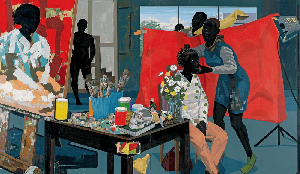From the burst of colors to the feel of canvas, from pastoral landscapes to protest art, the world of art has always been a dynamic space for self-expression, cultural exploration, and boundary-pushing storytelling—without words.
For centuries, Black artists have fought against racism, inequality, and sexism, channeling these struggles into their art and reimagining the traditional art history canon.
Let’s delve into the lives and work of some influential figures in the art world whose contributions are both significant and unforgettable.
Joshua Johnson (1763 – 1824)
A true pioneer, Joshua Johnson proudly identified himself as a self-taught genius. He holds the distinction of being the first known African American painter to make a career out of art. In the 1990s, art historians uncovered that Johnson was the son of an enslaved woman and a white man. His father purchased him from another slave owner and freed him when he was nineteen. Shortly after gaining his freedom, Johnson began offering his services as a portraitist, likely learning to paint while still enslaved. His work was rediscovered more than a century after his death, with details about his life emerging much later.
Edmonia Lewis (1844-1907)
Born in New York to parents of Afro-Haitian and Native American descent, Edmonia Lewis became the first African American female artist to gain international recognition. She attended Oberlin College, the first co-ed institution to admit Black women. After Oberlin, she moved to Boston, where she studied under Edward James Brackett, a specialist in marble busts of abolitionists—a craft that Lewis herself would master.
After achieving financial success with her sculptures, she relocated to Rome in 1866, where Renaissance and neoclassical art influenced her work. However, she continued to focus on Black, abolitionist, and Native American subjects. Her sculptures, exhibited at the 1876 Philadelphia World’s Fair and commissioned by figures like former President Ulysses Grant, are now housed at prestigious institutions like the Metropolitan Museum of Art and the Smithsonian.
Gordon Parks (1912-2006)
Gordon Parks was one of the first Black photojournalists and film directors to authentically capture the Black experience through his lens. Hired by the Farm Security Administration (FSA) during the Great Depression, he documented American life with a focus on African Americans. Parks later became one of the first Black fashion photographers for Vogue and was hired by Life magazine, where he wrote and photographed essays and co-founded Essence magazine.
As Hollywood’s first highly acclaimed Black director, Parks is credited with inventing the “blaxploitation” genre in the 1970s, centering films on African-American life and featuring Black actors.
Jacob Lawrence (1917-2000) At just 23 years old, Jacob Lawrence began work on his iconic Migration Series—a set of 60 panels depicting the migration of African Americans from the southern states to northern cities between 1910 and 1930.
With his use of abstract forms, primary colors, and dynamic movement, Lawrence rethought American history and the contemporary Black experience. He became the first Black artist to have a retrospective at MoMA in 1940. Today, his works are displayed in major museums like the Met and the National Gallery of Art.
Faith Ringgold (1930-2024) Born in Harlem, Faith Ringgold was a multimedia artist whose work explored themes of family, race, class, and gender. She earned her bachelor’s and master’s degrees from the City College of New York and went on to teach in both the New York City Public School system and at the college level.
In 1973, she left public school teaching to focus on her art full-time. Ringgold’s varied artistic practice spanned painting, quilts, sculptures, performance art, and children’s books. Throughout her career, she received over 80 awards and honors, along with 23 honorary doctorates.
Through their groundbreaking work, these accomplished artists celebrate diversity, challenge societal norms, and shed light on critical issues with innovative approaches and powerful narratives. Their art inspires us to embrace the rich tapestry of human experiences and perspectives that art offers.
Africa News of Wednesday, 21 August 2024
Source: face2faceafrica.com

















